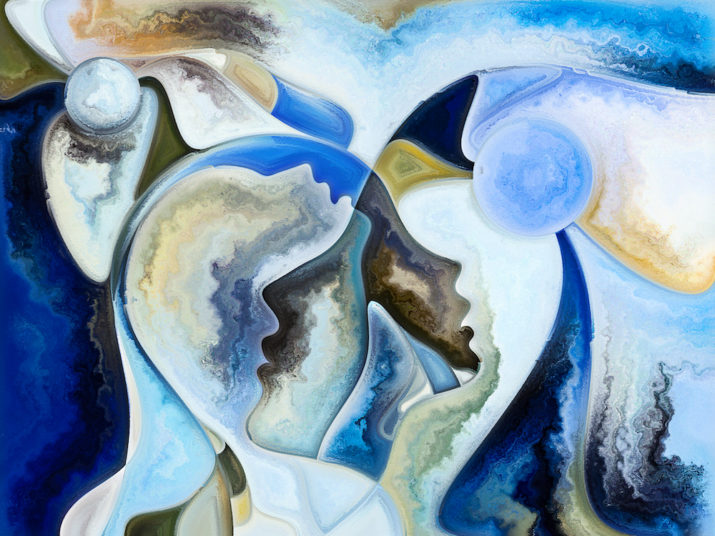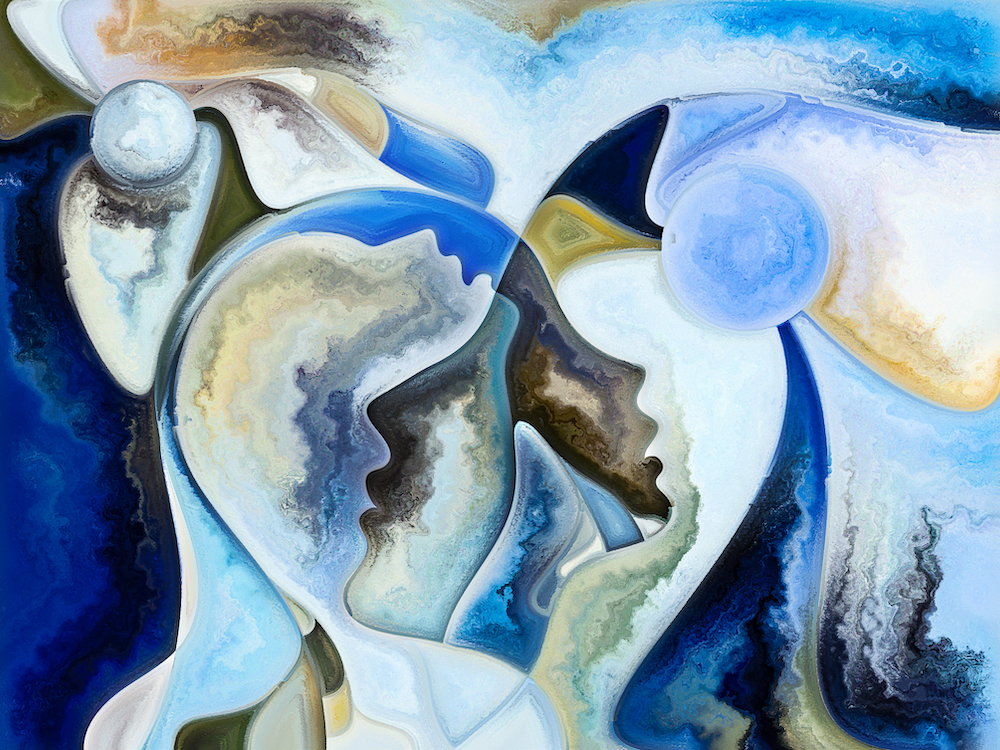

This is part of our special feature, Rethinking the Human in a Multispecies World.
“Is there anyone who has not, at least once, walked into a room and ‘felt the atmosphere?’” So asks Teresa Brennan in her 2004 book The Transmission of Affect―a beautiful exploration of the affective power of social and physical relations. Affect, according to Anna Hickey-Moody, is “…the virtuality and materiality of the increase or decrease effected in a body’s power of acting” (2016, 259) and manifests through social relations but also human/non-human intra-actions. While the idea that humans are affected by their environment, the energies of others, or even the objects or decor of a room is often acknowledged in conversations about teaching, no-one seems quite sure what to do with this knowledge. The transmission of affect is therefore, as Brennan suggests, a “conceptual oddity;” a phenomenon that doesn’t fit in a world where education is individualized; where knowledge is measured by cognitive load on the brain, and the body is overlooked (unless unruly, and in need of managing in some way). Teaching decisions are nonetheless made every day that relate in some way to “atmosphere” and the role of non-humans in its creation: the placing of furniture, the seating arrangements of children, the choice of classroom and the selection of pedagogical activities. This essay therefore raises the questions: what happens when we pay attention to the way in which objects and things interact with us? And what might change for education when we re-inscribe teaching as a process of dealing with multiplicities of bodies-in-relation?
Posthuman thinking
Not all of us can say, with any degree of certainty, that we have always been human, or that we are only that. Some of us are not even considered fully human now, let alone at previous moments of Western social, political and scientific history (Braidotti 2013, 1).
Before I explore affect and the non-human further, I want to explain a little more about posthuman philosophy. I first engaged with the theory back in 2013, at Professor Rosi Braidotti’s Posthuman Summer School at the University of Utrecht. At the time, I was working in teacher training, preparing people for work in schools, colleges, and community education, and had become disillusioned with the instrumental and transactional nature of current systems and practices. I wanted to explore alternative paradigms which accepted the complexity of our times while offering new approaches.
The critical posthumanism of Braidotti and others differs from other strands (actor network theory, transhumanism, anti-humanism, and so on) in that it is not philosophy as such, but a “…theoretically-powered cartographical tool” (Braidotti 2013, 12), or a lens through which to read the world. The latter is a fitting analogy for a practice which draws heavily on the work of Baruch Spinoza, a Dutch philosopher and optical lens grinder. Posthumanism is essentially a final call to “…mark the end of the self-reverential arrogance of a dominant Eurocentric notion of the human, and to open up new perspectives” (Braidotti and Hlavajova 2018, 3). It requires us to make a double move; the first, going beyond, or afterhumanism as we augment and reposition the voices of those overlooked and oppressed by Enlightenment ideas of “humanity.” The second move is post-anthropocentrism; the decentering of the human and elevation of other species and ecological systems which have been relegated beneath “Man” in an exploitative and limiting hierarchy. This convergence of ideas – which are often dealt with separately – necessitates complex, non-binary responses to the questions of our times.
Taking a “posthuman turn” in education therefore involves a shift from learning-as-cognition to a focus on connections between humans and non-human others; a move from the primacy of the written and spoken word to the re-emergence of the embodied self; and a recognition that other-than-human agents are always present in processes of learning. It is important to remember here however, as Zoe Todd (2016) reminds us, that many of these ideas are not new but have been enacted and inscribed as part of Indigenous cosmologies for centuries. While some notions of posthumanism continue the colonial erasure of Indigenous thought and practice, posthumanism with an ethics of relational reciprocity calls us to account for and augment the voices of those silenced in preference of those from the overwhelmingly white, male, and Western academy. Avoiding the co-opting of traditional worldly-knowings as “new” discoveries or novel contributions to knowledge thus requires a deliberate inclusion of Indigenous scholars. For example, the notion of “affective pedagogies” is akin to the idea of “learning spirit” spoken of by the Mi’kmaq First Nations people (Battiste 2013); a long-articulated belief and understanding of the world. There is therefore an ethical imperative to turn to non-Western Indigenous ontologies, not via a process of “cognitive colonialism,” but with ethical hesitation and humility (Wu et al. 2018). As Braidotti states in her acknowledgement, we need to account for different perspectives: “We are in this together; but we are not one and the same” (2019, 52). For myself, this is an ongoing process of learning and reflecting.
A posthuman approach to pedagogy therefore brings in a range of perspectives from different fields of scholarship that together act to decenter the humanistic values which privilege the individual (and certain kinds of individual at that) while also resisting Cartesian dualisms which separate body from mind, teacher from learner, and human from non-human others. Thus, in the words of Carlson (2015, xi)
The posthuman challenge…calls for forms of democratic education, curriculum and pedagogy that deconstruct the commonsense, taken-for-granted naturalness of humanism, not from an anti humanist perspective but as a movement beyond…whilst still maintaining the modernist and humanists projects of rights, justice, equity and freedom.
After studying these ideas, I returned to my own classes of student teachers inspired and yet keen to cut through some of the more inaccessible “high theory” which surrounds posthuman thinking. As a practitioner, I wanted to explore alongside my students questions like:
What would a post-human teacher education curriculum look like?
How can we elevate the non-human agents that impact so significantly on our practice?
How can we transform scholarship to promote ontologies which have been derided and left out of academic discourse?
And, while doing all this – how can we stay with the trouble of being part of the systems we resist?
The posthuman turn
Humans can no longer ignore nonhumans…they end up haunting the words we use and interrupting everyday talk. (Timothy Morton)
Our educational establishments in England, in the mainstream at least, have changed little over the past century. Separate disciplines, standard buildings and classroom layout, fixed patterns to the school day, standardized testing, and strict uniform regulations all speak to a hegemonic view of what schooling is, or should be. Despite the shift to online learning during the COVID-19 pandemic, the discourse of “return to normality” has reified the traditional model of schooling and situated the idea of education as contained and centralized firmly in the traditions of schooling-as-usual. Nevertheless, the idea of schools as symbiotic and living environments, infused with non-human actors (objects, organisms, viruses, and so on) speaks to an increasing sense of blurred boundaries, further emphasized by the lived reality of COVID-19. This challenge to the dualistic beliefs (which have previously separated humans both physically and ideologically from the natural world) bring to mind Stacy Alaimo’s (2016, 17) thoughts on the home, which could equally apply to educational establishments: “…domestic space has served as the defining container for the Western ‘human,’ a bounded space, wrought by delusions of safety, fed by consumerism, and fueled by nationalist fantasies.” By focusing only on the (human) individual as “man of reason” in pedagogical and curriculum design, what other agents and experiences are being missed?
Snaza et al (2014, 40) invite us to consider material things that make schools:
…sites that contain: networks of wire and pipe linking the buildings’ architecture to the subterranean infrastructures of cities and beyond that to the swirls of the oceans and global deposits of prehistoric dead organisms waiting to be mined and refined; dead nonhuman animals on plates in cafeterias, as well as on feet, human bodies, athletic equipment, and biology dissection trays; innumerable microorganisms, weeds, and insects colonizing every nook and cranny…
Starting from the assumption that educational experiences are not simply about the actions of teachers and students thus invites new possibilities and understandings. An interesting starting point, or provocation for educators is to invite them to consider the everyday objects or phenomena that intra-act with their teaching practice and elevate them to consciousness, thus acknowledging the “thinginess of things” (Bennett 2010). This brings into focus the material agents in classrooms; the things that are present and yet so often ignored.
Educating for and about a world that is not only “for us” but one that elevates animals, plants, and the wider eco-systems on which we rely is a further vital shift in times of ecological destruction. For Wallin, this is a pedagogy that teaches using “the filthy lesson of symbiosis” (Wallin, in Carstens 2018). In this trans-species paradigm, the Earth becomes “Gaia,” a self-regulating organism within which species are interconnected and interdependent; or “Sila,” the Inuit conception of life force (a concept that is difficult for non-Indigenous scholars to put into words, but one that expands notions of climate and weather into knowledge and wisdom; see Qitsualik, 2001). Along similar lines, UNESCO in late 2019 instigated the “Futures of Education: Learning to Become” global initiative, which attempts to shape the future of the planet by addressing learning in a world of complexity, uncertainty, and precarity (UNESCO 2019). The project, which describes learning as “a continual unfolding that is ongoing and life-long” (ibid.) resonates with posthuman and Indigenous ideas of process, potentiality, and different ways of knowing. The Common Worlds Research Collective, an interdisciplinary network of new materialist and feminist scholars, was commissioned to produce a background paper to assist in the drafting of the final report; its vision, which draws on Indigenous epistemologies, contains seven visionary declarations for education. The paper begins by outlining the problems posed by educational systems that are rooted in anthropocentric thinking, and concludes with a commitment to collectivist ethics (Common Worlds Collective 2020).
More-than-human education
Without stories of progress, the world has become a terrifying place. The ruin glares at us with the horror of its abandonment. It’s not easy to know how to make a life, much less avert planetary destruction. Luckily there is still company, human and not human. We can still explore the overgrown verges of our blasted landscapes – the edges of capitalist discipline, scalability, and abandoned resource plantations. We can still catch the scent of the latent commons – and the elusive autumn aroma (Anna Lowenhaupt Tsing).
How, then – in a practical sense – can educators defamiliarize themselves from ideas of education-as-usual and turn to non-human agents? In the final section of this essay, I will explore some examples of educational practice that go beyond the human-centered model of understanding learning and development to enact the kind of philosophies described above.
Pedagogies of affect and matter have been particularly explored in early childhood education whereby children are seen as being closer to the material world and there is greater acceptance of embodied responses to human and non-human agents. Bessie Dernikos, (2020) for example, turns to the role of soundscapes in the primary classroom as affective sites, which, once noticed and analyzed, expose the social norms of whiteness. In Dernikos’ inquiry, paying attention to sound reveals that some noises are viewed as significant while others are ignored or demonized. For example, while the excited involuntary exclamations of childrens’ joy and laughter (while reading) were frowned upon and silence was continually reinforced, other noises (school bells or announcements; traffic; music outside) were not; demonstrating that certain sounds (and who is making them) matter. Dernikos also describes the way in which children related differently to a particular book when the character shared their first name; reading shifted from a collective to a group activity and the normative pedagogical ideal of silent reading was disrupted. The intra-action of sound, book and children “… [created] temporal complications and anachronistic episodes that disturb [ed] the linear time of progress” (Eshun, in Dernikos 2020, 152). In this way, attending to “fleshy frequencies” (material, embodied responses to teaching stimuli) which draw lines of flight from the status quo of normative classroom behavior can offer new insights into the way that learning is enacted.
Other feminist thinkers have taken similar ideas and enacted them in research studies that promote the agency of material items such as school uniforms, advertisements, and slippers (Wolfe and Rasmussen 2020; Ringrose and Regehr 2020; and Taylor 2018, respectively). The acknowledgement that we, as humans, are always partially constituted by the non-human is an important recognition, which de-centers “Man” as other entities are brought into focus. The teachers’ role then expands to take account of interactions between bodies and materials; as Snaza (in Dernikos et al. 2020, 113) states
Classrooms are not just spaces where ideas are aired, shared, critiqued and debated; they are sites where affects emerge, circulate, and enter into conflict. (And this circulation far exceeds the human). Pedagogy is at least as much a matter of affect modulation as it is a question of theories, evidence, argument and genealogies.
In my own practice, I have evoked the role of “pedagogista” in order to explore the idea of affect modulation with other teachers. Drawn from the Reggio Emilia program of anti-fascist schooling, a pedagogista’ is “someone who is devoted to thinking about pedagogical possibilities” (Vinitmilla 2018, 21). The pedagogista traditionally troubles and problematizes engrained assumptions and ways of understanding education by “being-in-question” and “putting-into-question” (ibid., 22), moving between educational centers in a role that works similarly in a procedural sense (but conceptually and ethically very differently) to a state educational advisor. In this way it offers a counter-point to standard continuing professional development (CPD) processes of observation, leadership development, and coaching/mentoring which typically individualize and promote linear solutions to complex educational issues.
In these pedagogical experiments, I invited teachers to delve into their non-human educational landscapes. We explored the various assemblages of items that made up our classroom environments and considered the stories they told—social, cultural and material—and how these affected the ways in which students and teachers interacted with them. Using artistic practices, such as poetry and art allowed us to connect with our embodied (as well as cognitive responses); creating raw, collaborative art works allowed us to better represent our entangled and complex experiences. In this way educators were able to explore and disrupt understandings of education-as-usual and subsequently reflect on the implications of this for their own future teaching roles.
New ecologies of belonging
The discussions and explorations around the role of the non-human in education strike at the very heart of what it means to be human in the twenty-first; and test the engrained beliefs of Enlightenment thinking and their validity for our present times. Transdisciplinary development practices involving art, dialogue, and engagement with posthuman philosophies can thus offer new insights and agency.
By breaking with ideals that center the human (and by troubling what kind of humans have been centered at the expense of others), posthumanism offers new ecologies of belonging to both each other and the wider environment (Braidotti 2013). Our current predicament calls for a curriculum that encourages notions of kinship with non-human others; accepts complexity; and reframes our attachment to a shared world. Posthumanism can offer a much-needed affective turn towards the kind of social justice that accounts for difference; enacted through a process of de-familiarization from the dominant vision of education.
Kay Sidebottom is a Lecturer in Education and Childhood at Leeds Beckett University. Her current research explores how teachers can work with posthuman ideas to facilitate meaningful and disruptive education spaces for our complex times. With a background in community and adult education, her pedagogical specialisms include radical and anarchist education, arts-based practice, and community philosophy. She can be found on Twitter @KaySocLearn.
References
Alaimo, Stacy. 2016. Exposed: Environmental Politics and Pleasure in Posthuman Times. Minnesota: University of Minnesota Press.
Battiste, Marie. 2013. Decolonizing Education: Nourishing the Learning Spirit. Saskatoon, SK: Purich Publishing Ltd
Bennett, Jane. 2010. Vibrant Matter: A Political Ecology of Things. Durham, N.C: Duke University Press.
Braidotti, Rosi. 2019. Posthuman Knowledge. Cambridge: Polity Press.
Braidotti, Rosi. 2013. The Posthuman. Cambridge: Polity Press.
Braidotti, Rosi, and Maria Hlavajova. 2018. Posthuman Glossary. London: Bloomsbury Academic.
Brennan, Teresa. 2004. The Transmission of Affect. Ithaca: Cornell University Press.
Carlson, Dennis. 2015. “Forward.” In Posthumanism and Educational Research edited by Nathan Snaza and John Weaver, viiii-xii. New York: Routledge.
Carstens, Delphi. 2018. “The Politics of Animality and Posthuman Pedagogy.” In Socially Just Pedagogies: Posthumanist, Feminist and Materialist Perspectives in Higher Education edited by Vivienne Bozalek, Rosi Braidotti, Tamara Shefer and Michalinos Zembylas. London: Bloomsbury Academic.
Common Worlds Research Collective (2020). “Learning to become with the world: Education for future survival.” UNESCO Futures of Education report (forthcoming, 2021).
Dernikos, Bessie. 2020. “Tuning into ‘fleshy’ frequencies: A posthuman mapping of affect, sound and de/colonized literacies with/in a primary classroom.” Journal of Early Childhood Literacy, 20, no.1, 134-157. https://doi.org/10.1177/1468798420914125
Hickey-Moody, Anna. 2016. “A Femifesta for Posthuman Art Education: Visions and Becomings.” In: Posthuman Research Practices in Education edited by Carol A.Taylor and Christine Hughes. London: Palgrave.
Morton, Timothy. 2017. Humankind: Solidarity with Non-human People. London: Verso.
Qitsualik, Rachel Attituq. 2018. “Learning to observe, read Sila important to Inuit.” Indian Country Today. Accessed 10 September 2021. https://indiancountrytoday.com/archive/learning-to-observe-read-sila-all-important-to-inuit
Ringrose, Jessica, and Kaitlyn Regehr. 2020. “Feminist Counterpublics and Public Feminisms: Advancing a Critique of Racialized Sexualization in London’s Public Advertising.” Signs: Journal of Women in Culture and Society, 46, no.1. https://doi.org/10.1086/709362
Snaza, Nathan, et al. 2014. “Towards a Posthumanist Education.” Journal of Curriculum Theorizing, 30, no. 2, 39-55.
Snaza, Nathan. 2020. “Love and Bewilderment: on Education as Affective Encounter.” In Mapping the Affective Turn in Education (Theory, Research and Pedagogies) edited by Bessie Dernikos, Nancy Lesko, Stephanie D. McCall, and Alyssa Niccolini, 108-122. New York: Routledge.
Taylor, Carol. A. 2018. “Edu-crafting posthumanist adventures in/for higher education: A speculative musing”, Parallax, 24, no. 3, 371-381. https://doi.org/10.1080/13534645.2018.1496585
Todd, Zoe. 2016. “An Indigenous Feminist’s Take On The Ontological Turn: ‘Ontology’ Is Just Another Word For Colonialism”, Journal of Historical Sociology, 29, no.1, 4-22. https://doi.org/10.1111/johs.12124
Tsing, Anna Lowenhaupt. 2015. The Mushroom at the End of the World: On the Possiblity of Life in Capitalist Ruins. Princeton: Princeton University Press.
Vintimilla, C.D. 2016. “Encounters with a Pedagogista”. Contemporary Issues in Early Childhood, 19, no.1, 20-30.https://doi.org/10.1177/1463949116684886
Wolfe, Melissa, and Mary Lou Rasmussen. 2020. “The Affective Matter of (Australian) School Uniforms: The School Dress that is and does.” In Mapping the Affective Turn in Education (Theory, Research and Pedagogies) edited by Bessie Dernikos, Nancy Lesko, Stephanie D. McCall, and Alyssa Niccolini, 179-193. New York: Routledge.
Wu, Jinting, et al. 2018. “Perturbing possibilities in the postqualitative turn: lessons from Taoism (道) and Ubuntu.” International Journal of Qualitative Studies in Education, 31, no.6, 504-519. https://doi.org/10.1080/09518398.2017.1422289
Photo: Relationships in Texture series. Composition of people faces, colors, organic textures, flowing curves suitable as a backdrop for the projects on inner world, love, relationships, soul and Nature | Shutterstock
Published on November 9, 2021




